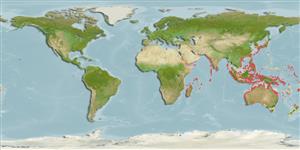Common names from other countries
Classification / Names / Names
Nomes comuns | Sinônimos | Catalog of Fishes (gen., sp.) | ITIS | CoL | WoRMS
Environment: milieu / climate zone / depth range / distribution range
Ecologia
; intervalo de profundidade 0 - 20 m (Ref. 81749). Tropical
Indo-Pacific.
Length at first maturity / Tamanho / Peso / Idade
Maturity: Lm ? range ? - ? cm Max length : 0.3 cm WD macho/indeterminado; (Ref. 3679)
Known from subtidal areas, inhabiting coral Montipora caliculata, in upper slopes (Ref. 106682).
Life cycle and mating behavior
Maturidade | Reprodução | Desova | Ovos | Fecundidade | Larvas
Members of the superorder Thoracica are mostly hermaphroditic. Broadcast spawners, fertilization occurs in the mantle cavity. Life cycle: Eggs hatch into planktonic nauplii and leave the mantle cavity. Afterwards, they undergo six naupliar instars succeded by nonfeeding cypris larva (settling stage) which later metamorphose into adults.
Achituv, Y. 2004. (Ref. 3679)
Status na Lista Vermelha da IUCN (Ref. 130435)
Status no CITES (Ref. 108899)
Not Evaluated
Not Evaluated
Perigo para os humanos
Harmless
Uso pelos humanos
| FishSource |
Ferramentas
Mais informação
Nomes comunsSinônimosPredadoresReproduçãoMaturidadeDesovaFecundidadeOvosDesenvolvimento dos ovos
Idade/Tamanho
Crescimento
Comprimento-peso
Comprimento-comprimento
Morfologia
Larvas
Abundância
Fontes da internet
Estimates based on models
Preferred temperature
(Ref.
115969): 21 - 29.3, mean 28.2 (based on 2827 cells).
Vulnerabilidade
Low vulnerability (10 of 100).
